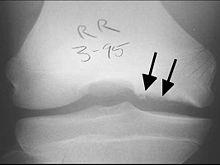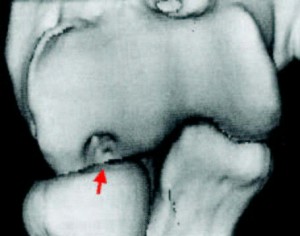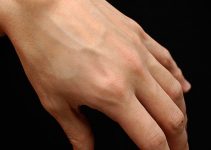Are you suffering from swollen and painful joints in your arms or legs, along with increasing weakness in the affected region? Watch out, for the problem could be Osteochondritis dissecans (OCD) – a condition affecting the joints. Read and know all about the disease, including its various causes, symptoms, diagnosis and treatment.
Osteochondritis dissecans Definition
Page Contents
- 1 Osteochondritis dissecans Definition
- 2 Osteochondritis dissecans ICD9 Code
- 3 Osteochondritis dissecans Incidence
- 4 Osteochondritis dissecans Types
- 5 Osteochondritis dissecans Causes
- 6 Osteochondritis dissecans Symptoms
- 7 Osteochondritis dissecans in Dogs
- 8 Osteochondritis dissecans Diagnosis
- 9 Osteochondritis dissecans Staging
- 10 Osteochondritis dissecans Differential Diagnosis
- 11 Osteochondritis dissecans Treatment
- 12 Osteochondritis dissecans Management
- 13 Osteochondritis dissecans Risk Factors
- 14 Osteochondritis dissecans Complications
- 15 Osteochondritis dissecans Prognosis
- 16 Osteochondritis dissecans Prevention
Osteochondritis dissecans (OCD) is a joint disorder in which a strip of cartilage, as well as a thin underlying bone layer, comes loose from a bone end. The disease is most commonly observed in young males, especially following an injury to a joint.
Osteochondritis dissecans ICD9 Code
The ICD9 Code for the disorder is 732.7.
Osteochondritis dissecans Incidence
This is a rare disorder that affects only 15-30 individuals out of a population of 100,000 every year. Although it is uncommon, OCD is a significant cause of joint pain in adolescents who are physically active.
Osteochondritis dissecans Types
The condition has been classified into two main types:
Picture 1 – Osteochondritis dissecans
Juvenile form
It arises with an open epiphyseal plate.
Adult form
It develops after the closure of the physis.
Osteochondritis dissecans Causes
It is not known what exactly leads to this disorder. The condition is supposed to arise due to a deficiency in the amount of blood flowing to the end of the bone that is affected. This may happen as a result of repetitive trauma, or minor episodes of small unrecognized injuries that have damaged the end of the impaired bone.
The condition is also believed to have a genetic association which makes some individuals more susceptible to it than others.
Osteochondritis dissecans Symptoms
The various signs and symptoms associated with this disorder include:
Pain
Pain is the most common symptom of this condition and may get triggered due to activities like participation in sports, climbing a ladder or even walking up stairs.
Locking or popping of joints
Patients may also find their affected joint popping or getting stuck in one place if a loose fragment gets in between the bones at the time of movement.
Weakness in joints
Sufferers may also find their impacted joint(s) steadily weakening or “giving way.”
Reduced range of motion
Patients may also be unable to straighten their arm or leg completely.
Tenderness and inflammation
Sufferers may also experience tenderness in their joints and find them swollen in appearance.
The disorder commonly affects the knee of sufferers. Around 85% of lesions on the knee are present on the medial femoral condyle. The ankle and the elbow are the next most common spots to be affected. In very rare cases, the articulations of the wrist, shoulder, hand or hip are found to be impacted.
When OCD affects the elbow, patients may not be able to move the joint beyond 90 degrees. In normal conditions, a healthy individual is able to extend an unaffected elbow fully straight – to 180 degrees.
Osteochondritis dissecans in Dogs
The disorder affects large-breed dogs of a young age and usually affects their fore limb, making it limp. Some dogs have a more prominent limp and are unable to support any weight. The lameness and pain tend to worsen with exercise and improve with rest. The problem could arise due to multiple factors, such as nutrition deficiency, rapid growth, genetics, trauma to the joint or hormonal imbalance. The disorder has also been found to occur during stages of rapid growth in a dog. Physical exam, consideration of medical history and radiographs (x-rays) are usually enough to detect this disorder in dogs. The treatment of the condition is the same in dogs as in humans – requiring conservative medical treatment or surgical cure.
Dog breeds that are most susceptible to this disease include:
- Bernese mountain dogs
- English setters
- Great Danes
- Labrador retrievers
- Newfoundlands
- Old English sheepdog
- Rottweilers
Osteochondritis dissecans Diagnosis
The diagnosis of OCD involves one or more of the following tests:
Magnetic Resonance Imaging (MRI)
MRI scans make use of a strong magnetic field and radio waves, to create detailed images of both soft and hard tissues. Physicians often use MRI to determine whether an affected joint needs surgery or would heal with conservative treatment options. MRI is usually a preferred diagnostic test for OCD as it creates detailed images without exposing patients to radiation.
X-rays
These tests can reveal abnormalities in the bones of joints. A physician may recommend carrying out x-rays of both the left and the right knee to compare the status of the joints.
Computerized Tomography (CT) Scan
In this procedure, X-ray images are taken from various angles to create cross-sectional images of different internal structures. These scans help visualize bone as well as cartilage of affected areas of the body. This aids in exactly identifying the area where loose fragments are present inside the joint.
Osteochondritis dissecans Staging
OCD has been classified into various stages, based on the health and joint condition of patients:
Stage I
It is characterized by low signal changes and thickening of cartilage of the affected joint.
Stage II
In this phase, the joint cartilage is interrupted and a fibrous attachment is indicated by low-signal rim at the back of fragment.
Stage III
As in Stage II, the joint cartilage is interrupted and there are high signal changes at the back of the fragment as well as the underlying subchondral bone.
Stage IV
It is marked by the appearance of the separated fragment as a loose body inside the joint.
Osteochondritis dissecans Differential Diagnosis
The symptoms of OCD are quite similar to those of a few other conditions, such as:
- Osteoarthritis
- Septic arthritis
- Bone cysts
- Inflammatory arthritides
In adults and children, Osgood-Schlatter disease may give rise to symptoms similar to OCD. However, the pain in such cases is generally localized to the associated tendinous insertion. Patients may also suffer from overlying inflammation and tenderness.
Physicians should ensure that the symptoms that an affected individual is complaining of are not the result of any of the above conditions.
Osteochondritis dissecans Treatment
The treatment for OCD aims to restore normalcy to the functioning of the impacted joint. It also intends to reduce the painful sensations experienced by sufferers and lower the risk of osteoarthritis. There is no one-size-fits-all cure for this disorder. In children having bones growing still, this defect of the bone may heal after some resting period and adequate protection to it.
The standard treatment measures for this condition include:
Therapy
In the initial stages, physicians are very likely to recommend certain conservative measures. These may involve the following:
Providing rest to the joint
Patients should keep away from all activities that can put stress on their affected joint, such as running and jumping, and worsen their condition. Some sufferers may need using crutches for some time, particularly in case the pain is severe enough to make them limp while moving about. Physicians may advise some patients to wear a brace to keep their injured knee immobilized for a few weeks.
Physical therapy
This type of therapy frequently involves range-of-motion exercises, stretching and strengthening workouts for the muscles which provide support to the affected joint. Following an operative procedure, physical therapy is also often recommended as a follow-up management measure.
Surgery
In cases where the condition fails to heal even after 3-6 months after use of conservative treatment measures, physicians may recommend using an operative procedure. Surgical correction for OCD involves removal of loose fragments or re-attachment of fragments to the affected bone.
Based on the size of the fragment that has come loose, or the small bone fractures underlying the separated fragment, operation may be used to fill in the space with fibrocartilage (cartilage comprising of collagen fiber bundles). In many individuals, these techniques can be executed in an arthroscopic manner, i.e, by pushing surgical tools and a fiber-optic camera through tiny incisions around the impacted joint.
Recently, surgeons have started using a new operative process that uses the bone marrow from the body of the patient itself to restructure the damaged region of the knee in affected individuals. Following the execution of the method, new tissue begins to grow quickly to fill up the region where the bone fragment was removed.
Osteochondritis dissecans Management
The management measures for OCD include:
Picture 2 – Osteochondritis dissecans Image
Drugs
Painful sensations may be alleviated to some extent with the aid of non-steroidal inflammatory drugs (NSAIDs) or simple analgesics. NSAIDs do the affect the course of the condition as no major inflammatory component is involved.
Supportive measures
These include gentle physiotherapy, immobilization, use of braces and protective training and stoppage of sporting activities for several weeks.
Osteochondritis dissecans Risk Factors
The risk factors for this condition include:
Age
OCD is most common in individuals aged between 10 and 20 years. The median age of development of this condition is approximately 11 years.
Sex
The disorder is more likely to affect males than females. This could be due to a higher participation of males in sports activities than females.
Participation in sports activities
Participating in sports activities that involve lots of throwing, jumping or rapid changes in direction put the joints at an increased risk of getting affected by OCD.
Osteochondritis dissecans Complications
A joint affected by OCD is very likely to develop a dreaded condition known as osteoarthritis, marked by chronic degeneration of cartilage in an impacted joint.
Osteochondritis dissecans Prognosis
The outcome of this disorder is based on the age of an OCD sufferer, the affected joint as well as the stage of the lesion.
Osteochondritis dissecans Prevention
The occurrence of this disease might be prevented by educating adolescents and young people participating in sports and activities that can affect their joints with overuse and result in the development of OCD. The risk of injury can be prevented by learning the proper techniques of participating in stability and strength training.
If you have been experiencing pain or soreness in a joint for quite some time now, it is important for you to seek medical attention on an immediate basis and get yourself diagnosed quickly to check whether you are actually suffering from OCD. A delay in treatment is most likely to slacken your pace of recovery and make the condition worsen to give rise to various complications. Early detection and treatment can do just the opposite, ensuring quicker recovery for you.
References:
http://www.mayoclinic.com/health/osteochondritis-dissecans/DS00741
http://en.wikipedia.org/wiki/Osteochondritis_dissecans
http://www.patient.co.uk/doctor/osteochondritis-dissecans
http://www.medicinenet.com/osteochondritis_dissecans/article.htm



